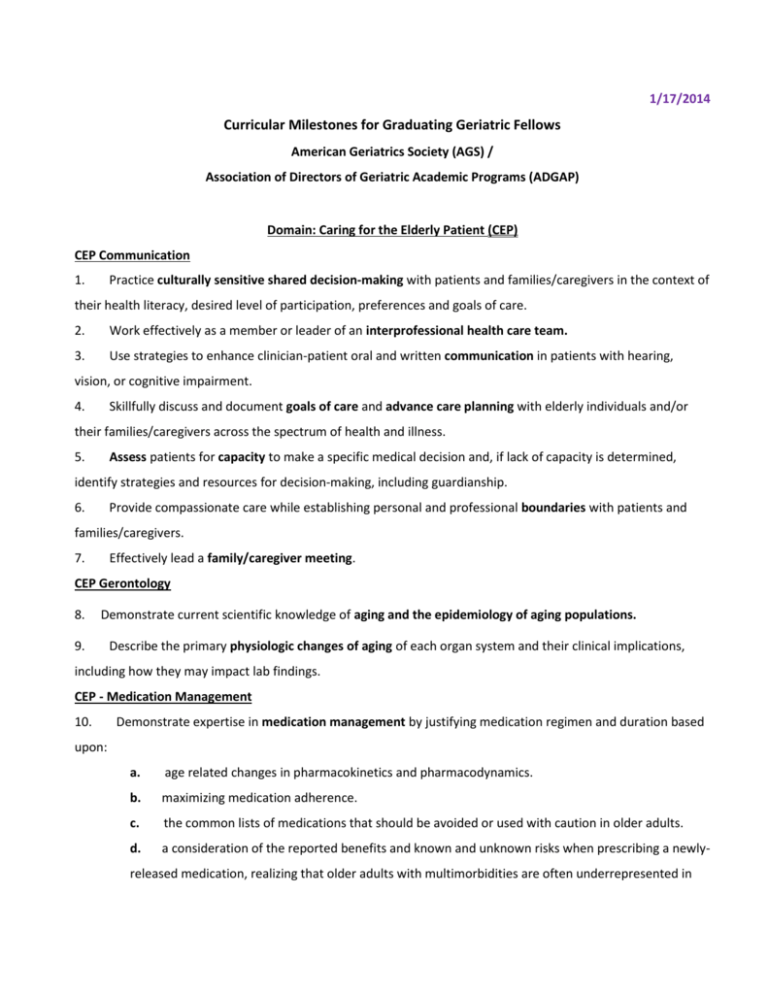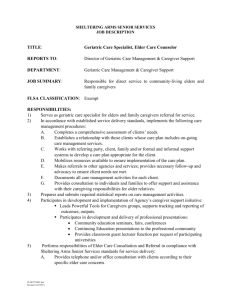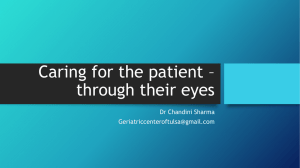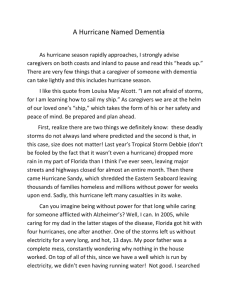Geriatric Fellowship Curriculum Milestones - 22.13 KB
advertisement

1/17/2014 Curricular Milestones for Graduating Geriatric Fellows American Geriatrics Society (AGS) / Association of Directors of Geriatric Academic Programs (ADGAP) Domain: Caring for the Elderly Patient (CEP) CEP Communication 1. Practice culturally sensitive shared decision-making with patients and families/caregivers in the context of their health literacy, desired level of participation, preferences and goals of care. 2. Work effectively as a member or leader of an interprofessional health care team. 3. Use strategies to enhance clinician-patient oral and written communication in patients with hearing, vision, or cognitive impairment. 4. Skillfully discuss and document goals of care and advance care planning with elderly individuals and/or their families/caregivers across the spectrum of health and illness. 5. Assess patients for capacity to make a specific medical decision and, if lack of capacity is determined, identify strategies and resources for decision-making, including guardianship. 6. Provide compassionate care while establishing personal and professional boundaries with patients and families/caregivers. 7. Effectively lead a family/caregiver meeting. CEP Gerontology 8. Demonstrate current scientific knowledge of aging and the epidemiology of aging populations. 9. Describe the primary physiologic changes of aging of each organ system and their clinical implications, including how they may impact lab findings. CEP - Medication Management 10. Demonstrate expertise in medication management by justifying medication regimen and duration based upon: a. age related changes in pharmacokinetics and pharmacodynamics. b. maximizing medication adherence. c. the common lists of medications that should be avoided or used with caution in older adults. d. a consideration of the reported benefits and known and unknown risks when prescribing a newly- released medication, realizing that older adults with multimorbidities are often underrepresented in clinical trials. 11. When a patient presents with a new symptom or geriatric syndrome, investigate whether a medication(s) is contributing. 12. Individualize pain control utilizing the most effective pharmacologic and nonpharmacologic strategies based on the etiology and chronicity of the patient's pain. 13. Prescribe pain medications with instructions and methods to prevent common complications including constipation, nausea, fatigue and opioid toxicity (myoclonus and hyperalgesia), using equianalgesic dosing conversion and opioid rotation when needed. CEP - Functional Impairment and Rehabilitation 14. Know the indications and contraindications for referring patients to physical, occupational, speech or other rehabilitative therapies, and refer if appropriate. 15. Know indications for durable medical equipment, prescribe and evaluate for appropriate use. 16. Recognize and manage the care of patients at high risk for poor outcomes from common conditions such as deconditioning, stroke, hip fracture, and dysphagia. CEP - Diseases in Older Adults 17. Identify and manage medical disorders that occur in older adults. 18. Know the different presentation, management and underlying pathophysiology of common diseases in older adults (including but not limited to: hypertension, coronary artery disease, osteoporosis, hypothyroidism, infections, and the acute abdomen; adjusting drug dosage for renal function). 19. Know the national guidelines for preventive care, adjust as appropriate for clinical circumstances or patient preferences, and document reasons if these guidelines are not followed. 20. Recognize the limitations of the evidence base and critically review the medical literature for studies that are valid and applicable to the care of older adults. CEP - Complex Illness (es) and Frailty in Older Adults 21. Identify patients who are frail or otherwise at risk for death, dependency and/or institutionalization over the next few years. 22. Demonstrate the ability to manage the care of patients with multimorbidities by integrating the evidence, patient's goals, life expectancy and functional trajectory. Document clinical reasoning when management differs from standard treatment recommendations. 23. Demonstrate the ability to manage psychosocial aspects of the care of older adults including interpersonal and family relationships, living situations, adjustment disorders, bereavement, and anxiety. 24. Assess and incorporate family/caregiver needs and limitations, including caregiver stress, into patients' management plans. 25. Provide geriatric consultation in all settings with attention to multimorbidity, age-related changes in physiology, function, treatment efficacy and response, medication management and psychosocial issues. 26. Regularly re-assess goals of care to recognize patients likely to benefit from palliative and/or hospice care, including those with non-cancer diagnoses (e.g, Congestive Heart Failure, Chronic Obstructive Pulmonary Disease, Dementia). CEP Palliative and End of Life Care 27. Counsel patients and families/caregivers about the range of options for palliative and end of life care. 28. Assess, manage, and provide anticipatory guidance for patients and families/caregivers for common non pain symptoms during severe chronic illness or at the end of life. Domain: Systems-Based Care (SBC) for Elder Patients SBC General 29. Reduce iatrogenic events among elders in all settings through implementation of patient-specific and system-wide strategies to prevent falls*, immobility, delirium*, pressure ulcers*, incontinence*, malnutrition*, indwelling catheter use, nosocomial infections, deep vein thrombi, restraints, depression*, functional decline*. (NB: asterisk indicates additional competencies in syndromes or functional impairment section.) 30. Demonstrate expertise in transitions of care by identifying, with the interprofessional team, the most appropriate care setting(s) for a patient, including independent living, assisted living, long-term care, acute rehabilitation , subacute rehabilitation, home care, primary care at home, adult day care, Program of All-Inclusive Care for the Elderly (PACE)-like program, and hospice based on the needs and preferences of the patient and families/caregivers, and the admission and payment requirements for each setting. 31. Demonstrate expertise in transitions of care by communicating the following to the receiving provider through discussion or timely discharge summary: medication reconciliation, an assessment of patient’s cognition and function, pending medical results and follow-up needs. 32. Demonstrate knowledge of commonly accepted geriatric quality indicators. 33. Participate in quality improvement efforts to enhance the quality of care of older adults. 34. Describe the services provided by Medicare Parts A, B and D, the Hospice Benefit, and by Medicare and Medicaid for patients who are "dual eligible," including the basics of the patient’s fiscal responsibility for each. 35. Identify patient and family/caregiver needs and refer to appropriate local community resources. 36. Recognize and document signs of elder abuse and/or neglect and refer to community resources and adult protective services when appropriate. 37. Recognize the complexity of geriatric care and demonstrate the ability to prioritize care, in a time- efficient manner, during encounters with geriatric patients 38. Serve as an advocate for older adults and caregivers within various healthcare systems and settings. 39. Recognize health-care system issues that negatively impact the care of the geriatric patients, and identify improvement strategies. 40. Demonstrate the ability to teach patients, caregivers and others about aging-related healthcare issues. 41. Describe models of care that have been shown to improve outcomes for older adults, e.g., ACE Units, PACE, multifactorial interventions to prevent falls, delirium prevention. SBC Hospital Care 42. Reduce iatrogenic events (see SBC General #29) 43. Recognize common and subtle presentations of delirium and manage appropriately. 44. Perform pre-operative assessments for older patients and document specific peri-operative management recommendations to improve patient care and safety based on type of surgery and patient characteristics. SBC – Ambulatory Care 45. Perform and interpret an outpatient geriatric assessment, and develop a management plan that includes appropriate consultation with and referrals to other disciplines and community based resources. 46. Recognize patients who are at risk for hazardous driving, identify strategies to reduce risk, and integrate state and local laws into the management plan. SBC – Home Care 47. Perform home visits, demonstrate modification of the physical exam for the home setting, and assess physical safety of the environment. 48. Refer patients to appropriate home health and support services to maximize ability to remain in their homes. SBC – Long Term Care and Nursing Home Care 49. Individualize LTC patient management considering prognosis, comorbidity, patient and caregiver goals, and available resources especially in the following situations: (a) consideration for transfer to the acute care hospital; (b) weight loss, dehydration, swallowing disorders; (c) agitation and problem behaviors. 50. Describe the role of a long-term care medical director and demonstrate an understanding of nursing home and long-term care regulations and requirements, including the minimum data set. 51. Manage acute problems in long-term care via telephone call. Domain: Geriatric Syndromes (GS) GS - Falls and Dizziness 52. Perform and interpret common gait and balance assessments, recognizing abnormal gaits associated with specific conditions. 53. Conduct an appropriate evaluation of patients who fall or are at risk for falling, implement strategies to reduce future falls, fear of falling, injuries, and fractures, and followup on referrals. 54. Evaluate, manage, and refer (when appropriate) patients with symptoms of dizziness or lightheadedness, differentiating among those with single or serious causes and those that are multifactorial. GS - Cognitive, Affective, and Behavioral Health 55. Distinguish the clinical presentation and prognosis of changes in cognition and/or affect among people with normal aging, mild cognitive impairment, dementia, delirium, and depression. 56. Perform, interpret, and articulate the strengths and limitations of the commonly used cognitive and mood assessment tools. 57. Identify clinical situations where a psychiatric referral, psychological counseling, or neuropsychological assessment is indicated and integrate the findings into the patient's plan of care. 58. Diagnose and manage the potentially reversible/treatable causes of cognitive and affective changes in older adults. 59. Identify and manage depression. 60. Diagnose and manage the causes of dementia, including Alzheimer's disease, vascular dementia, Lewy body dementia, dementia of Parkinson's Disease, alcoholic dementia, frontotemporal dementia, Creutzfeldt– Jakob Disease and Normal Pressure Hydrocephalus as well as other rare causes. Recognize and appropriately refer ambiguous cases for further evaluation. 61. Care appropriately for patients at each stage of dementia (mild, moderate or severe) and provide anticipatory guidance based on prognosis and their goals of care. 62. Assess and manage cognitive, functional, and disruptive behavioral manifestations of dementia, both behaviorally and pharmacologically. GS - Pressure Ulcers 63. Recognize patient risk factors for pressure ulcers, and in high risk patients work with an interprofessional team to develop a prevention plan. 64. Stage pressure ulcers and demonstrate proficiency in describing their clinical characteristics (e.g., size, color, exudate). 65. Develop a treatment plan for pressure ulcers with an interprofessional team, incorporating the indications for surgical and non-surgical treatments for ulcers (e.g., debridement, classes of wound care products and treatments, pressure relieving devices, etc.). GS – Sleep Disorders 66. Provide initial evaluation and management of insomnia and other sleep disorders and, when indicated, refer to a sleep specialist. GS - Hearing and Vision Disorders 67. 68. Screen for hearing loss and recognize when referral is appropriate. Recognize common ophthalmologic conditions associated with aging, including changes of normal aging, cataract, glaucoma, age-related macular degeneration, and refer when appropriate to ophthalmology, optometry and/or low vision services GS - Urinary Incontinence 69. Identify, evaluate and treat the most common forms of both reversible and chronic urinary incontinence using nonpharmacological interventions where possible. 70. Refer when appropriate for urologic or gynecologic evaluation including urodynamic testing, pessary evaluations, pelvic floor muscle training. 71. Identify, evaluate and manage urinary retention and incomplete bladder emptying including the appropriate use of intermittent catheterization or indwelling bladder catheters. GS – Weight Loss and Nutritional Issues 72. Identify and appropriately evaluate and manage involuntary weight loss. 73. Discuss with patients and families/caregivers the risks and benefits of appetite stimulants, nutritional supplementation, enteral tube feeding, and parenteral nutrition, particularly in patients with advanced dementia or near end-of-life. 74. Identify swallowing disorders in patients with involuntary weight loss or recurrent pneumonias, and work with an interprofessional team to evaluate, manage, and educate patient and caregiver(s) based on goals of care. GS - Constipation and Fecal Incontinence 75. Identify, evaluate and manage constipation and fecal impaction using nonpharmacological and pharmacological modalities. 76. Identify and provide initial evaluation and management of fecal incontinence.









